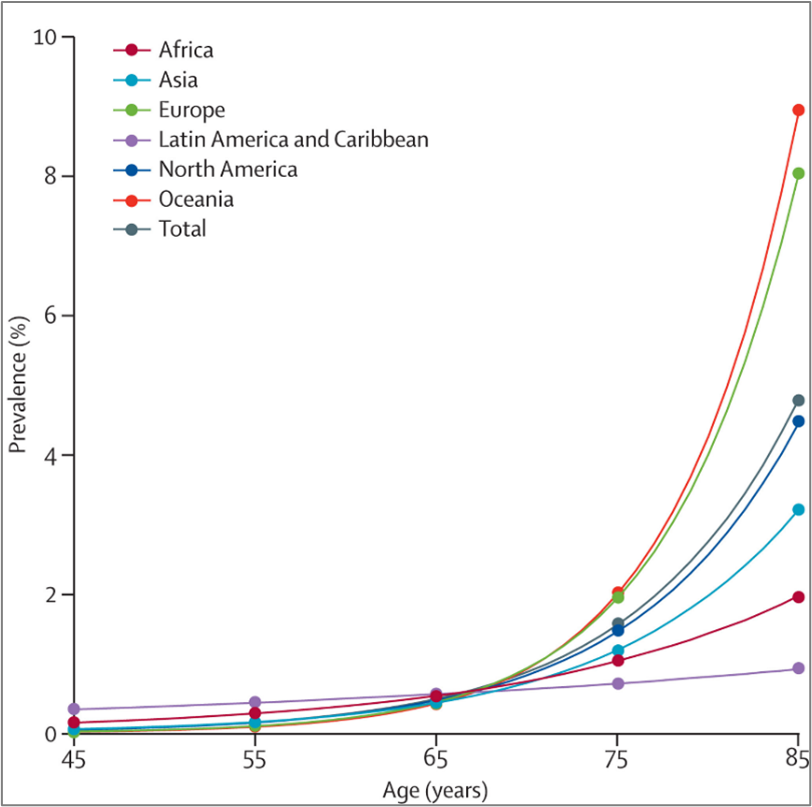When was your last eye test? Looking after our eyes as we age
By AAG member Dr Marianne Coleman, Clinical Vision Research Fellow, University of Melbourne / National Vision Research Institute
Maybe you’re reading this and thinking, ‘I’ve just had mine!’ Or perhaps you are thinking, ‘But I don’t need new glasses, I can see fine.’
In Australia, people aged 65 and over are entitled to an eye test under Medicare every year, whether they need new specs or not. If you’re under 65, this eligibility is every three years. What is it about hitting 65 that suddenly entitles you to more regular eye tests, and why bother with them? The reason the Government coughs up for these more frequent tests is that as we age, our risk of developing certain sight-threatening eye conditions increases. Exponentially.
To illustrate, the figure shows the exponential increase in late-stage age-related macular degeneration after the age of 65 years in Oceania (yes, we’re the bright red line at the top!).1 In the same way, after age 60 is when most cataracts arise2 and risk ratios for open-angle glaucoma quadruple.3
Many of these conditions are caused by ageing processes affecting the eye’s ‘garbage disposal system’, causing a buildup of debris which plays havoc with all the other systems that keep the eye healthy.
With our ageing population, we’re also seeing increased prevalence of vision impairment, with knock-on effects on mental health, social participation and quality of life. Yet 90% of the sight loss experienced by older adults is preventable if these associated conditions are detected early: cataracts can be removed, macular degeneration can be slowed in progression, eyedrops control glaucoma … you get the idea.
Bottom line: looking after your eyes is really important as you get older. Fortunately, all these conditions can be picked up as part of a routine eye examination by any registered optometrist.
Optometrists in Australia are a type of primary care; like a GP, but for your eyes. However, in Australia, the total population of over 65s in the last census outnumbers the number of MBS claims for initial eye tests in 2022 by 3 to 1. This suggests there are many people out there who are at greater risk of developing these eye conditions, but may not be accessing preventive care.
One group known to experience barriers to accessing preventive eyecare is people living with dementia, for whom sight loss is more prevalent compared to other adults the same age. Research has shown that people with dementia are less likely to see an optometrist, and less likely to receive sight-saving treatments for eye conditions at the hospital, such as cataract surgery. Yet good eyesight is important to reduce falls risk and help people with dementia safely take part in other activities to maximise their wellbeing, such as physical activity programs.
Our research project explored routine eye test experiences for people with dementia living at home, to identify ways to support access to preventive eyecare. We created resources about eye tests for people with dementia and carers, and a training course about dementia-friendly eyecare for optometrists. Now, you can search online to find a dementia-friendly optometrist. We hope that these and other research projects underway will help all older Australians to look after their eyes and reduce their risk of preventable sight loss, so they can see well, to live well.
More information
Dementia Australia – Eye health and dementia
Macular Disease Foundation Australia
Glaucoma Australia
Good Vision for Life
For AAG members, this blog is also available as a pdf.
References:
- Wong WL, Su X, Li X, Cheung CM, Klein R, Cheng CY, Wong TY. Global prevalence of age-related macular degeneration and disease burden projection for 2020 and 2040: A systematic review and meta-analysis. Lancet Glob Health. 2014 Feb;2(2):e106-16.
- Hashemi, H., Pakzad, R., Yekta, A. et al. Global and regional prevalence of age-related cataract: a comprehensive systematic review and meta-analysis. Eye 34, 1357–1370 (2020).
- Le A, Mukesh BN, McCarty CA, Taylor HR. Risk factors associated with the incidence of open-angle glaucoma: the visual impairment project. Invest Ophthalmol Vis Sci. 2003 Sep;44(9):3783-9.